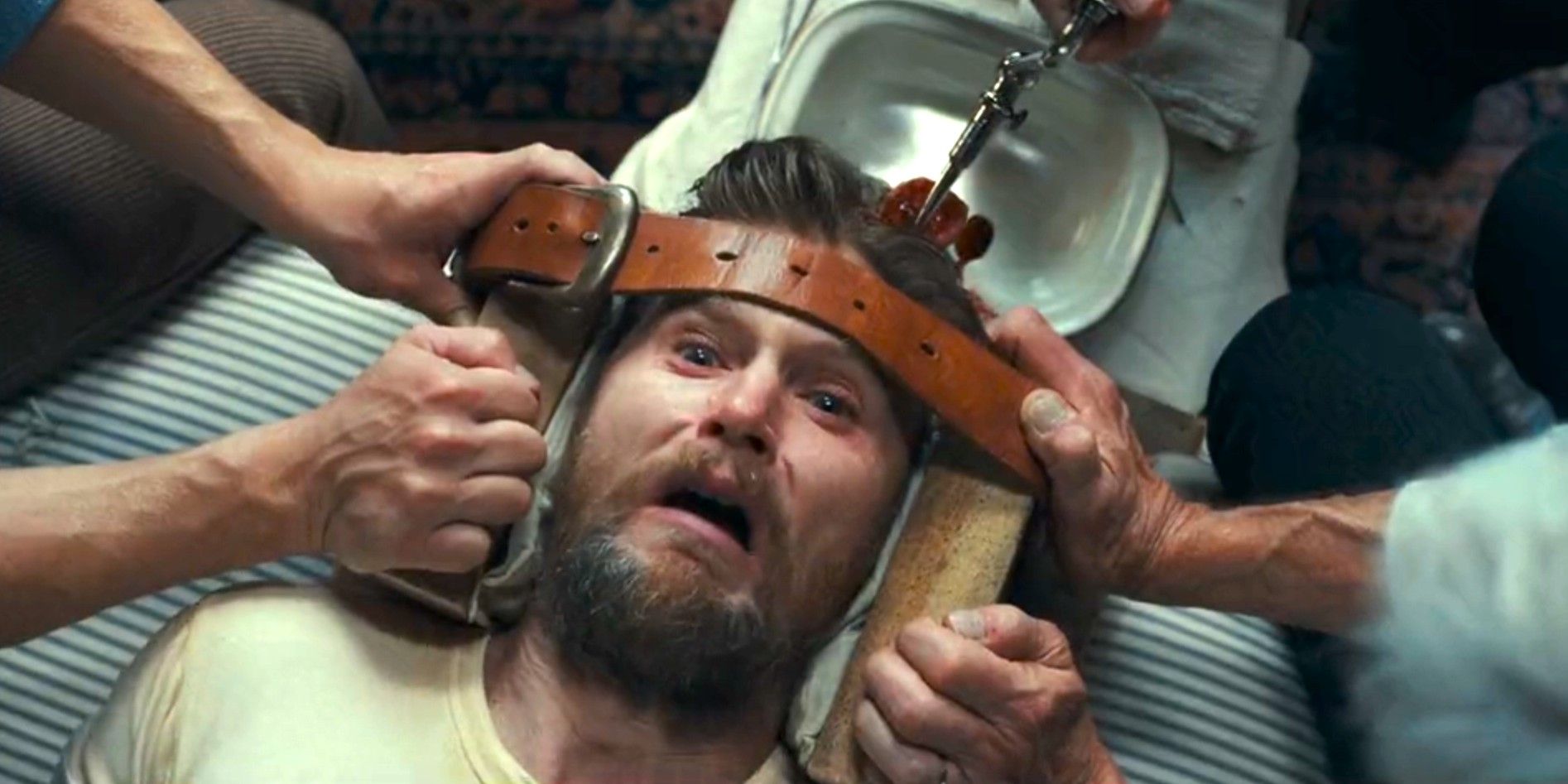The 10 Most Iconic Movie Props, Ranked
Summary Iconic movie props like the plastic bag in American Beauty can evolve into powerful symbols that enhance storytelling and captivate audiences.
Props like the One Ring in The Lord of the Rings trilogy transcend their fictional origins, becoming cultural touchstones that convey deeper themes.
The Mjölnir in the Marvel Cinematic Universe symbolizes heroism and character growth, serving as a visual emblem of strength and worthiness.
Movie props play a crucial role alongside actors and narratives, adding significant elements to a film, from character development to advancing the plot. Among these, several props have become major icons within popular film culture. These memorable objects have transcended their original context, becoming instantly recognizable symbols of the movies they appeared in. Their enduring presence in the collective consciousness is a testament to the profound impact of the films they were featured in.
While these props may have initially served a specific purpose within the story, their significance has grown over time, transforming them into beloved and iconic aspects of cinematic history. From the lightsabers of the Star Wars franchise to the golden ticket from the Willy Wonka movies, these props have captured the imagination of audiences and become an integral part of the cultural lexicon. The fascination with these iconic movie props continues to thrive, as they evoke nostalgia, inspire countless references and imitations, and serve as tangible reminders of the magic and storytelling power of cinema.
10 The Plastic Bag
American Beauty (1999)
Close
The white plastic bag's journey from a serendipitous find to an iconic prop is a testament to the power of simplicity in storytelling. Property master Lynda Reiss' tireless search for the perfect unmarked bag, despite budgetary constraints, underscores the importance of every detail in bringing a director's vision to life. The bag's lack of branding allows it to become a versatile symbol, reflecting the protagonist's inner world and the beauty he discovers in the ordinary.
Its graceful movement in the wind, captured by the character's video camera, creates a captivating visual that lingers long after the scene has ended. The plastic bag's ability to evoke emotion and convey meaning through its minimalistic presence demonstrates how even the most unassuming object can become a powerful tool in the hands of skilled filmmakers. This prop's iconic status is well-deserved, as it plays a crucial role in one of the film's most memorable and thought-provoking moments.
9 The One Ring
The Lord Of The Rings Trilogy (2001-2003)
Close
Crafted with meticulous attention to detail, the One Ring from the Lord of the Rings trilogy has become an iconic prop that transcends the boundaries of the fantasy genre. Its sleek, gold band and intricate Elvish inscriptions have become instantly recognizable, even to those who have never watched the films or read the original novels by J.R.R. Tolkien. The Ring's power to corrupt and tempt those who seek to possess it serves as a central theme throughout the story, driving the narrative forward as the diverse inhabitants of Middle-earth unite in their quest to destroy it.
The prop's significance is heightened by its association with the character of Frodo Baggins, the unassuming hobbit entrusted with the daunting task of carrying the Ring to Mount Doom. The One Ring's enduring legacy has been further solidified by its impact on popular culture. With references to its corrupting influence and Andy Serkis' iconic portrayal of Gollum permeating the zeitgeist, the One Ring will forever be associated with the iconic franchise.
8 The Mjölnir
Marvel Cinematic Universe
Close
Thor's legendary hammer, the Mjölnir, has become a symbol of strength, worthiness, and heroism within the Marvel Cinematic Universe. Its iconic design, featuring a short handle and a square-shaped head adorned with intricate engravings, makes it instantly recognizable to fans of the superhero genre. The hammer's significance in the MCU extends beyond its formidable destructive capabilities, showcasing the character of those who wield it.
Your browser does not support the video tag.
The memorable scene in which Captain America proves himself worthy of lifting the Mjölnir showcases the prop's ability to elevate the narrative and define pivotal moments in the franchise. The hammer's roots in Norse mythology add depth to its story, bridging the gap between ancient tales and modern-day superhero adventures. As a symbol of Thor's growth and the power of goodness, the Mjölnir has become an integral part of the MCU's visual language and a highly sought-after piece of memorabilia.
7 Hannibal Lecter's Mask
The Silence of the Lambs (1991)
Close
Silence of the Lambs The Silence of the Lambs follows FBI trainee Clarice Sterling (Jodie Foster) as she hunts a serial killer known as Buffalo Bill (Ted Levine). To find the killer, she must place her trust in the notoriously dangerous but brilliant cannibal, Dr. Hannibal Lecter (Anthony Hopkins). With Buffalo Bill's latest victim the daughter of a U.S. Senator, the pressure is on Sterling to catch the criminal before he can bring his twisted scheme to fruition. Director jonathan demme Release Date February 14, 1991 Runtime 118 minutes prequel(s) Hannibal Rising , Red Dragon , Manhunter
The eerie, cage-like mask that confines Hannibal Lecter in The Silence of the Lambs has become a symbol of the character's terrifying presence and the unsettling nature of his crimes. Its design serves a practical purpose within the film's narrative, protecting others from Lecter's cannibalistic tendencies while allowing him to breathe and communicate. The mask's open eyeline adds to its unnerving effect, enabling Lecter to maintain his piercing gaze and assert his psychological dominance over those around him.
The prop's ability to dehumanize the character paradoxically heightens his menace, transforming him into a caged beast whose intellect and cunning remain undiminished by his physical restraints. This iconic status of the mask is further cemented by its prominent role in the film's sequel, Hannibal, where it serves as a chilling reminder of Lecter's past and the lingering threat he poses to society. Lecter's use of the mask symbolizes the complexity of his character, blurring the lines between humanity and monstrosity.
6 The Neuralyzer
Men In Black (1997)
Close
Men In Black Where to Watch *Availability in US stream
rent
buy Not available Not available Not available Director Barry Sonnenfeld Release Date July 2, 1997 Runtime 98 minutes
In the world of Men in Black, the neuralyzer stands out as a quintessential piece of technology that has left a huge impact on pop culture. This unassuming, pen-like device possesses the power to erase the short-term memory of any witness to extraterrestrial activity, ensuring that the secretive work of the MIB remains hidden from the public eye. The neuralyzer's sleek, futuristic design perfectly encapsulates the film's blend of science fiction and comedy, making it an instantly recognizable prop that has become synonymous with the franchise.
Related How Men In Black's Neuralyzer Actually Works Men in Black's neuralyzer may seem like science fiction, but researchers at UC Davis have shown that the technology isn't too far-fetched.
The neuralyzer's crucial role in the narrative elevates it from a mere gadget to a key plot device, showcasing its originality and narrative significance within the film's universe. Its iconic status as a memory-wiping tool seamlessly integrates into the story, distinguishing it from more conventional weapons commonly seen in Hollywood blockbusters. This unique feature underscores its impact on the audience, contributing to its lasting impression.
5 The Golden Ticket
Willy Wonka And The Chocolate Factory (1971)
Close
Willy Wonka and the Chocolate Factory Where to Watch *Availability in US stream
rent
buy Not available Not available Not available Based on Roald Dahl's 1964 novel, Willy Wonka and the Chocolate Factory stars Gene Wilder as the titular eccentric candymaker who invites five children into his mysterious factory to show them how he creates his popular candies. The film mostly follows Charlie Bucket, a young boy from a poor family who miraculously wins one of the five Golden Tickets that allows him access to Wonka's factory tour. Director Mel Stuart Release Date June 30, 1971 Runtime 100 minutes
The golden ticket from Willy Wonka and the Chocolate Factory has become synonymous with hope, opportunity, and the fulfillment of dreams. The prop's shimmering, metallic surface and ornate design make it an instantly recognizable object, even to those who have never seen the film. The golden ticket's meaning within the story cannot be overstated, as it serves as a catalyst for Charlie's journey and the life-changing events that follow.
Your browser does not support the video tag.
Its scarcity and the worldwide frenzy surrounding its discovery underscore the ticket's value and the transformative power it holds for those lucky enough to find one. The prop's iconic status has transcended the confines of the film, becoming a cultural touchstone and a metaphor for rare opportunities and coveted experiences. The golden ticket's enduring popularity speaks to its ability to capture the imagination and evoke a sense of wonder, solidifying its place as one of the most memorable and beloved props in cinematic history.
4 The Wilson Ball
Cast Away (2000)
Close
Cast Away Where to Watch *Availability in US stream
rent
buy Not available Not available Not available Directed by Robert Zemeckis in his second collaboration with Tom Hanks, Cast Away tells the story of FedEx executive Chuck Noland, who strives to survive in a deserted island after a plane crash. The film, which mostly takes place in the uninhabited island, earned Hanks a Golden Globe for Best Actor in a Leading Role. Director Robert Zemeckis Release Date December 22, 2000 Runtime 143 minutes
Considered one of Tom Hanks’ best movies, Wilson the volleyball in Cast Away becomes an unlikely companion and a powerful symbol of the human need for connection in the face of isolation. The prop's transformation from a simple sports item to a personified friend is a testament to the character's resourcefulness and the depth of his loneliness. The blood-drawn face on the volleyball adds a haunting and visceral quality to the prop, underscoring the desperation and vulnerability of Chuck's situation.
Your browser does not support the video tag.
Wilson's presence in the film serves as a catalyst for Chuck's character development, providing him with an outlet for his thoughts and emotions, and ultimately helping him maintain his sanity during his prolonged isolation. The volleyball's iconic status is further cemented by its role in one of the film's most heart-wrenching scenes, where Chuck's anguished cries for his lost companion echo across the vast expanse of the ocean, highlighting the profound bond that can form between a person and an inanimate object under extraordinary circumstances.
3 Dorothy's Ruby Slippers
The Wizard of Oz (1939)
Close
The Wizard of Oz Based on Frank L. Baum's book of the same name, The Wizard of Oz follows young Dorothy Gale (Judy Garland) as she's swept away to the magical land of Oz. Upon arriving, she falls afoul of a witch, then enlists the help of a scarecrow, a tin man, and a lion in order to find the Wizard and get home to her family. Director Victor Fleming Release Date August 25, 1939 Runtime 102 minutes
An enduring symbol of the power of home and the resilience of the human spirit, Dorothy's ruby slippers from The Wizard of Oz have captured the imagination of generations. The vibrant red hue of the slippers stands in stark contrast to the sepia-toned world of Kansas, representing the magic and wonder of the Land of Oz. The prop's significance within the narrative is paramount, as the slippers serve not only as a source of protection for Dorothy, but also as her ultimate key to returning to her family.
Your browser does not support the video tag.
The iconic status of the ruby slippers extends far beyond the film itself, with their scarcity and value making them a highly sought-after piece of Hollywood history. The slippers' timeless design and the craftsmanship behind their creation have elevated them to the status of a cultural touchstone. The slippers will forever be an embodiment of the film’s legacy.
2 The Lightsaber
Star Wars Franchise
Close
Star Wars Star Wars is a multimedia franchise that started in 1977 by creator George Lucas. After the release of Star Wars: Episode IV- A New Hope (originally just titled Star Wars), the franchise quickly exploded, spawning multiple sequels, prequels, TV shows, video games, comics, and much more. After Disney acquired the rights to the franchise, they quickly expanded the universe on Disney+, starting with The Mandalorian. Created by George Lucas First Film Star Wars: Episode IV - A New Hope
Lightsabers have become synonymous with the Star Wars franchise, transcending their role as simple props to become cultural icons in their own right. The distinctive hum and glow of these energy-based swords have captured the imagination of audiences, embodying the mystical power of the Force and the eternal conflict between good and evil. Each lightsaber is a reflection of its wielder, with the color of the blade often indicating the character's alignment and personality, from the heroic blue and green of the Jedi to the menacing red of the Sith.
Your browser does not support the video tag.
The lightsaber's versatility in combat, capable of deflecting blaster fire and slicing through the toughest of materials, represents its importance as a weapon of choice for the galaxy's most powerful warriors. Beyond its practical applications, the lightsaber serves as a narrative device, illuminating the paths characters take and the choices they make, ultimately shaping their destinies and the fate of the galaxy itself. Its iconic status as a symbol of Jedi prowess and Sith domination further solidifies its role in the Star Wars saga.
1 Morpheus' Red and Blue Pills
The Matrix (1999)
Close
The Matrix Where to Watch *Availability in US stream
rent
buy Not available Not available Not available In a dystopian future, hacker Neo (Keanu Reeves) learns about the Matrix, a simulated reality hiding the truth of humanity's enslavement by machines. He joins rebels led by the mysterious Morpheus, who believes Neo is destined to free humanity. Betrayal leads to a deadly confrontation with villain Agent Smith as Neo discovers his true power, defeats his enemies, and promises to change the world. Director Lilly Wachowski , Lana Wachowski Release Date March 30, 1999 Runtime 136 minutes
The red and blue pills have become iconic props that represent a defining moment in The Matrix franchise, representing a powerful metaphor for the choice between truth and ignorance. The stark contrast between the two pills, one offering a path to enlightenment and the other a return to the comfortable illusion, has resonated with audiences long after the film's release. The props' significance lies not only in their visual impact, but also in the philosophical questions they raise about the nature of reality and the consequences of seeking knowledge.
Your browser does not support the video tag.
The act of Neo choosing the red pill has become a cultural shorthand for embracing the often difficult truth, while the blue pill represents the temptation to remain in blissful ignorance. The Wachowskis' use of these seemingly simple props as a narrative device has elevated them to the status of enduring symbols, sparking discussions and interpretations that extend far beyond the confines of the film.










COMMENTS